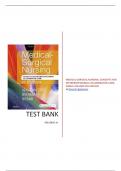Exam (elaborations)
TEST BANK FORMEDICAL-SURGICAL NURSING: CONCEPTS FOR INTERPROFESSIONAL COLLABORATIVE CARE, SINGLE VOLUME 9TH EDITION by Donna D. Ignatavicius (All chapters covered) (Complete Guide) (Graded A+)
TEST BANK FORMEDICAL-SURGICAL NURSING: CONCEPTS FOR INTERPROFESSIONAL COLLABORATIVE CARE, SINGLE VOLUME 9TH EDITION by Donna D. Ignatavicius (All chapters covered) (Complete Guide) (Graded A+)
[Show more]



